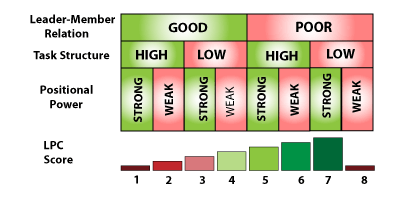Contingency theory of leadership emphasizes that effectiveness of leadership is dependent on matching a leader’s style to right situation.
Contingent Leadership
Contingency theory of leadership emphasizes that effectiveness of leadership is dependent on matching a leader’s style to right situation. This theory was originally developed by Fiedler after studying various leaders in different contexts, but predominantly military. Contingency theory inadvertently assumes that styles are behaviors that cannot be influenced or modified. It is contradictory to “situational-leadership” which stressed the need for leaders to adapt to the situation. The definition of “situation” is also different in the two theories, while it implies the development/readiness level of the organization in “situational-leadership” , it’s a complex combination of three factors in contingency theory.
Situations defined by Contingency Theory
These three factors are
- Leader-Member Relation – It is a measure of leadership acceptance between the organizational hierarchies. If the subordinates have trust, confidence and feel adequately motivated by their superiors, it’s positive.
- Task Structure – It’s a measure of the clarity of the project or tasks, their methods to achieve the end product. There are clear guidelines to follow and progressed can be easily tracked.
- Positional Power – It’s a measure of amount of authority the leader has to influence the productivity of the followers, whether he can reward or punish them. The positional power can be weak if the subordinates do not directly report to the leader, a matrix organization or task that is sub-contracted to an external organization.
Least Preferred Coworker Scale
Fiedler also created a Least Preferred Co-worker (LPC) scale to determine the style of a leader. The LPC is a questionnaire for a leader that is directed to determining the kind of co-worker a leader would like to work with. It is indirectly aimed to reflect upon the leader’s own style of operations. A high score in LPC indicates a “people-orientated” style while low score indicates “task-oriented” style. The LPC is based on the assumption that a task-oriented leaders perceive their least-preferred-coworker more negatively than relationship-oriented leaders. Essentially they view them as underachievers and people who are an obstacle to their own performance. While relationship-oriented leader will derive some satisfaction out of interpersonal factors and give more positive feedback. To evaluate your LPC score, click here.
 Contingency Theory Model
Contingency Theory Model
The Fiedler’s contingency model tries to match a leader’s style which is evaluated using LPC to the situation. Leaders who are predominantly task-oriented (low LPC) are more effective in situations 1,2,3 & 8, while those who are relationship-oriented (high LPC) are effective in situations 4-7. The contingency theory implies that leaders will not be effective in all situations, but only the one’s that suits them best. One explanation is that a mismatched leader-situation causes a lot of anxiety to the leader; the stress compels him to make unfair and wrong decisions resulting in negative outcomes.
Common Observations on Contingency Model
- Building relationships matters most when there is significant mistrust and insecurities with leadership’s intentions and methods.
- Highly structured tasks are relatively independent of either relationship or positional power. It might be due to time tested methods and process that normally accompany the highly structured task, the leader’s influence in minimal.
- Low structured task can be accomplished by either directive or participative leadership style.
- Low positional power always requires leaders to use their people-skills to influence the outcome.
- When situations are really bad, like a crisis (poor leader-member relation, low task structure & weak positional power), only a strong task-oriented leader can be effective.
Strengths of contingency theory
- It is supported by vast amount of empirical studies (~400) and has been tested extensively.
- The contingency model is predictive; there is a well defined method to evaluate both LPC and Situations.
- The theory reduces the amount of expectations from a leader, instead it focuses on matching a leader to task.
- It can be used to create leadership profiles in an organization, thus can be a valuable instrument during a reorganization/management change. The new organizational structure can then be matched to profiles of the leaders.
Criticism of contingency theory
- It fails to explain the model that is developed empirically; it is unable to provide reasons for leadership’s effectiveness in various situations.
- The LPC scale is very debatable, it is hard to understand how evaluation of a coworker can reflect upon own leadership style.
- The contingency theory is not a leadership development process, while it is good to get the best out of a leader, it doesn’t blend well with the career growth of a leader. If the leader doesn’t adapt or changes his style, he might never be productive at the higher levels of organization. This is one of the most common problems in large organizations, managers are promoted since they perform well at a particular level, but since they are not fit for the new responsibilities, they lead to overall ineffectiveness of whole organization.
